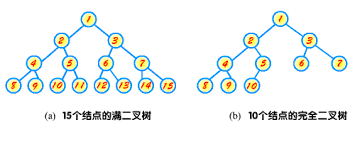-
-
Notifications
You must be signed in to change notification settings - Fork 738
Description
Given a complete binary tree, count the number of nodes.
Note:
Definition of a complete binary tree from Wikipedia:
In a complete binary tree every level, except possibly the last, is completely filled, and all nodes in the last level are as far left as possible. It can have between 1 and 2h nodes inclusive at the last level h.
Example:
Input:
1
/ \
2 3
/ \ /
4 5 6
Output: 6
这道题给定了一棵完全二叉树,让我们求其节点的个数。很多人分不清完全二叉树和满二叉树的区别,下面让我们来看看维基百科上对二者的定义:
A Complete Binary Tree (CBT) is a binary tree in which every level, except possibly the last, is completely filled, and all nodes are as far left as possible.
对于一颗二叉树,假设其深度为d(d>1)。除了第d层外,其它各层的节点数目均已达最大值,且第d层所有节点从左向右连续地紧密排列,这样的二叉树被称为完全二叉树;
换句话说,完全二叉树从根结点到倒数第二层满足完美二叉树,最后一层可以不完全填充,其叶子结点都靠左对齐。
A Perfect Binary Tree(PBT) is a tree with all leaf nodes at the same depth. All internal nodes have degree 2.
二叉树的第i层至多拥有 

A Full Binary Tree (FBT) is a tree in which every node other than the leaves has two children.
换句话说,所有非叶子结点的度都是2。(只要你有孩子,你就必然是有两个孩子。)
其实这道题的最暴力的解法就是直接用递归来统计结点的个数,根本不需要考虑什么完全二叉树还是完美二叉树,递归在手,遇 tree 不愁。直接一行搞定碉堡了,这可能是我见过最简洁的 brute force 的解法了吧,参见代码如下:
解法一:
class Solution {
public:
int countNodes(TreeNode* root) {
return root ? (1 + countNodes(root->left) + countNodes(root->right)) : 0;
}
};
我们还是要来利用一下完全二叉树这个条件,不然感觉对出题者不太尊重。通过上面对完全二叉树跟完美二叉树的定义比较,可以看出二者的关系是,完美二叉树一定是完全二叉树,而完全二叉树不一定是完美二叉树。那么这道题给的完全二叉树就有可能是完美二叉树,若是完美二叉树,节点个数很好求,为2的h次方减1,h为该完美二叉树的高度。若不是的话,只能老老实实的一个一个数结点了。思路是由 root 根结点往下,分别找最靠左边和最靠右边的路径长度,如果长度相等,则证明二叉树最后一层节点是满的,是满二叉树,直接返回节点个数,如果不相等,则节点个数为左子树的节点个数加上右子树的节点个数再加1(根节点),其中左右子树节点个数的计算可以使用递归来计算,参见代码如下:
解法二:
class Solution {
public:
int countNodes(TreeNode* root) {
int hLeft = 0, hRight = 0;
TreeNode *pLeft = root, *pRight = root;
while (pLeft) {
++hLeft;
pLeft = pLeft->left;
}
while (pRight) {
++hRight;
pRight = pRight->right;
}
if (hLeft == hRight) return pow(2, hLeft) - 1;
return countNodes(root->left) + countNodes(root->right) + 1;
}
};
我们也可以全用递归的形式来解,如下所示:
解法三:
class Solution {
public:
int countNodes(TreeNode* root) {
int hLeft = leftHeight(root);
int hRight = rightHeight(root);
if (hLeft == hRight) return pow(2, hLeft) - 1;
return countNodes(root->left) + countNodes(root->right) + 1;
}
int leftHeight(TreeNode* root) {
if (!root) return 0;
return 1 + leftHeight(root->left);
}
int rightHeight(TreeNode* root) {
if (!root) return 0;
return 1 + rightHeight(root->right);
}
};
这道题还有一个标签是 Binary Search,但是在论坛上看了一圈下来,并没有发现有经典的二分搜索的写法,只找到了下面这个类似二分搜索的解法,感觉应该不算严格意义上的二分搜素法吧,毕竟 left,right 变量和 while 循环都没有,只是隐约有点二分搜索法的影子在里面,即根据条件选左右分区。首先我们需要一个 getHeight 函数,这是用来统计当前结点的左子树的最大高度的,因为一直走的是左子结点,若当前结点不存在,则返回 -1。我们对当前结点调用 getHeight 函数,得到左子树的最大高度h,若为 -1,则说明当前结点不存在,直接返回0。否则就对右子结点调用 getHeight 函数,若返回值为 h-1,说明左子树是一棵完美二叉树,则左子树的结点个数是 2^h-1 个,再加上当前结点,总共是 2^h 个,即 1<<h,此时再加上对右子结点调用递归函数的返回值即可。若对右子结点调用 getHeight 函数的返回值不为 h-1,说明右子树一定是完美树,且高度为 h-1,则总结点个数为 2^(h-1)-1,加上当前结点为 2^(h-1),即 1<<(h-1),然后再加上对左子结点调用递归函数的返回值即可。这样貌似也算一种二分搜索法吧,参见代码如下:
解法四:
class Solution {
public:
int countNodes(TreeNode* root) {
int res = 0, h = getHeight(root);
if (h < 0) return 0;
if (getHeight(root->right) == h - 1) return (1 << h) + countNodes(root->right);
return (1 << (h - 1)) + countNodes(root->left);
}
int getHeight(TreeNode* node) {
return node ? (1 + getHeight(node->left)) : -1;
}
};
我们也可以写成迭代的形式,用一个 while 循环,感觉好处是调用 getHeight 函数的次数变少了,因为开头计算的高度h可以一直用,每下一层后,h自减1即可,参见代码如下:
解法五:
class Solution {
public:
int countNodes(TreeNode* root) {
int res = 0, h = getHeight(root);
if (h < 0) return 0;
while (root) {
if (getHeight(root->right) == h - 1) {
res += 1 << h;
root = root->right;
} else {
res += 1 << (h - 1);
root = root->left;
}
--h;
}
return res;
}
int getHeight(TreeNode* node) {
return node ? (1 + getHeight(node->left)) : -1;
}
};
Github 同步地址:
类似题目:
Closest Binary Search Tree Value
参考资料:
https://leetcode.com/problems/count-complete-tree-nodes/
